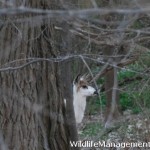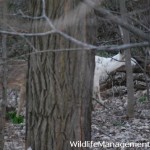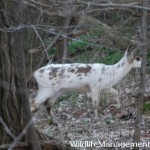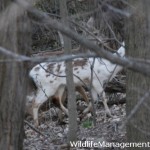Reader Submitted: “My four month old pup and I have been trying to track this “white deer” nightly that we spotted a few weeks ago. Out on our third floor balcony of my apartment, we both heard crashing through the woods. Out in the distance, I see the piebald deer with a large herd. I run inside my place to grab my camera and mount the telephoto lens since the deer was so far out. Turn camera on, point… camera is dead. I ran inside, put the battery on charge and hope I get a little bit of juice to shoot with as I wait for the deer to get closer.
All of a sudden, a buck breaks free and tears through the woods. I run inside, grab the battery, pop it in cam and wait. About 20 seconds later, the rest of deer follow up behind him. By some luck, the camera had enough juice to snap a few quick photos of the piebald before dying completely. My puppy was at my heels barking at the deer the entire time.
I have sent the four pictures of the piebald deer that I took. Hope you like the pics! I hope the deer comes back again. Talking to neighbors, I hear she has been around and sighted a few times in the Stow and Tallmadge, Ohio area. We see whitetail deer around here all the time, but this is the first piebald that we have noticed. How exciting!”
On Piebald Deer
Hunters commonly call these colorful deer calico or pinto deer. The piebald condition is an inherited genetic trait. The piebald anomaly ranges from a very slight amount of white hair to almost totally white coats. Unlike true albinos, piebald deer have brown eyes and black hooves. The piebald condition is frequently associated with other harmful physical conditions, including skeletal deformities (dorsal bowing of the nose, short & deformed legs, curved spine, short lower mandible) and internal organ deformities.
Piebald deer are not common, usually occurring at less than one percent of the population. Piebald deer can be more common in certain areas, especially in places where deer hunters protect them. Piebald deer are not afforded any special protection under hunting regulations and from a wildlife management standpoint it is not recommend that these animals be protected.




I have had a piebald for over a year roaming our yard and woods we named him Pie last year. He was always alone last year and this spring another white tail joined him. Now I am happy to see him grazing with six to seven deer. Six have racks and one appears to be female.
It sounds like you have a great deer herd at your place!! Very cool!